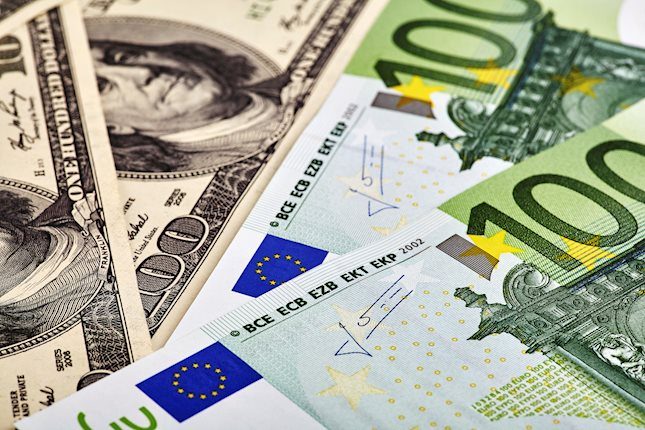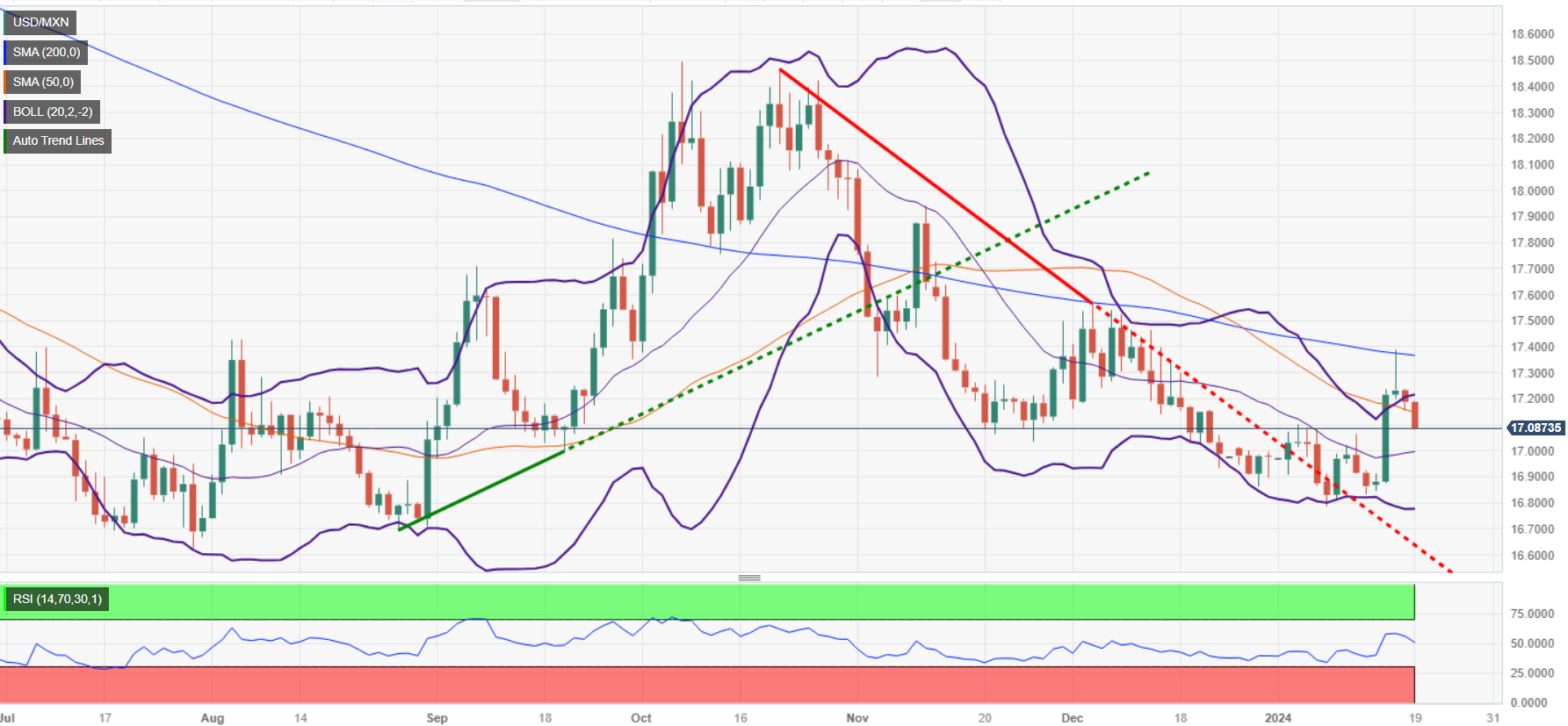Most recent article: Mexican Peso trips down on a firm US Dollar
- Mexican Peso appreciates more than 0.15%, overcoming weak Retail Sales data and sluggish economic growth projections.
- Former Banxico Deputy Governor Elizondo suggests a continued tight monetary policy stance in Mexico.
- Improved US Consumer Sentiment and revised inflation expectations likely capped the Peso’s advance.
The Mexican Peso (MXN) stages a comeback against the US Dollar (USD), but it remains set to register losses of more than 1.20% in the week after Retail Sales in the country missed estimates, growing less than expected. In addition, the National Statistics Agency (INEGI) revealed that Mexico’s economy would likely grow below the 3% expected by analysts in December in a preliminary reading by the Timely Indicator of Economic Activity (IOAE). Nevertheless, the USD/MXN exchanges hands at 17.08, down by 0.47%, favoring the emerging market currency.
In the meantime, former Bank of Mexico (Banxico) Deputy Governor Everardo Elizondo commented that it’s too soon to relax monetary policy in Mexico, adding, “There are enough reasons to remain worried.” Elizondo added, "if [policy] is loosened, inflationary expectations will deteriorate.”
Across the border, Consumer Sentiment improved, according to a University of Michigan poll, and households downwardly revised inflation expectations for one and five-year periods.
Daily digest market movers: Mexican Peso regains control amid mixed Mexico data
- Mexico’s Retail Sales rose by a minimum of 0.1% MoM, below forecasts of 0.5% and trailing October’s 0.7%. Annually the indicator slowed from 3.4% to 2.7%, lower than estimates of 3.2%.
- Mexico’s INEGI revealed that the Timely Indicator of Economic Activity (IOAE) anticipates economic growth of 2.6% in December.
- The preliminary reading from the Michigan Consumer Sentiment Index reached its highest level since the summer of 2021 and came in at 78.8, exceeding forecasts of 70 and the previous reading of 69.7. Joanne Hsu, the Director of Surveys of Consumer, said, “Consumer views were supported by confidence that inflation has turned a corner and strengthening income expectations.”
- US households’ inflation expectations for one year dropped from 3.1% to 2.9% and from 2.9% to 2.8% for five years.
- Existing Home Sales fell in December as supply showed signs of improvement, according to the National Association of Realtors. Sales rose by 3.78 million, below estimates of 3.82 million and trailed November’s 0.8% increase.
- The US economy remains robust, as most data suggests the economy continues to expand at a steady pace. The Atlanta GDPNow model suggests last year’s Q4 would likely expand by 2.4%, spurred by strong retail sales, firm industrial production, a tight labor market and consumer sentiment improvement.
- Following the release of the Michigan survey of consumer sentiment, investors continued to trim bets on rate cuts by the Federal Reserve. At the beginning of the week, the swaps market priced in 175 basis points of rate cuts in 2024. But following solid US data this week, those were trimmed to 150 bps.
- The strongest catalyst in the week has been Federal Reserve Governor Christopher Waller’s speech: “No reason to move as quickly or cut as rapidly as in the past.” This kept investors in check despite supporting rate cuts if inflation indeed gets lowered.
- Mexico witnessed a jump in headline inflation, but core data suggests the Bank of Mexico (Banxico) has done a good job, curbing elevated prices after hiking rates toward 11.25%.
- Despite indications from the December meeting minutes of Banxico (the Central Bank of Mexico) that the bank may consider easing its monetary policy, the inflation report for December poses a potential obstacle to any such policy relaxation.
- Analysts at Standard Chartered noted, “We expect the policy rate to be lowered to 9.25% by end-2024, although an official downward revision in the output gap could open the door for more aggressive rate cuts.”
- On January 5, a Reuters poll suggested the Mexican Peso could weaken 5.4% to 18.00 per US Dollar in the 12 months following December.
Technical analysis: Mexican Peso stays firm as USD/MXN meanders around 100-day SMA
The USD/MXN remained trading sideways on Friday, though with a tilt to the upside as buyers reclaimed the 17.00 psychological barrier. If they push the exchange rate toward the 200-day Simple Moving Average (SMA) at 17.36, that could pave the way to test the 100-day SMA at 17.42. That level comes ahead of the December 5 high at 17.56 and the May 23 high of 17.99.
On the other hand, the ongoing pullback below 17.20 could pave the way for a drop toward the 17.00 figure. Once cleared, further downside is expected at the January 8 low of 16.78. Once surpassed, the next support would be the August 28 cycle low of 16.69, ahead of last year’s low of 16.62.
USD/MXN Price Action – Daily Chart
Central banks FAQs
What does a central bank do?
Central Banks have a key mandate which is making sure that there is price stability in a country or region. Economies are constantly facing inflation or deflation when prices for certain goods and services are fluctuating. Constant rising prices for the same goods means inflation, constant lowered prices for the same goods means deflation. It is the task of the central bank to keep the demand in line by tweaking its policy rate. For the biggest central banks like the US Federal Reserve (Fed), the European Central Bank (ECB) or the Bank of England (BoE), the mandate is to keep inflation close to 2%.
What does a central bank do when inflation undershoots or overshoots its projected target?
A central bank has one important tool at its disposal to get inflation higher or lower, and that is by tweaking its benchmark policy rate, commonly known as interest rate. On pre-communicated moments, the central bank will issue a statement with its policy rate and provide additional reasoning on why it is either remaining or changing (cutting or hiking) it. Local banks will adjust their savings and lending rates accordingly, which in turn will make it either harder or easier for people to earn on their savings or for companies to take out loans and make investments in their businesses. When the central bank hikes interest rates substantially, this is called monetary tightening. When it is cutting its benchmark rate, it is called monetary easing.
Who decides on monetary policy and interest rates?
A central bank is often politically independent. Members of the central bank policy board are passing through a series of panels and hearings before being appointed to a policy board seat. Each member in that board often has a certain conviction on how the central bank should control inflation and the subsequent monetary policy. Members that want a very loose monetary policy, with low rates and cheap lending, to boost the economy substantially while being content to see inflation slightly above 2%, are called ‘doves’. Members that rather want to see higher rates to reward savings and want to keep a lit on inflation at all time are called ‘hawks’ and will not rest until inflation is at or just below 2%.
Is there a president or head of a central bank?
Normally, there is a chairman or president who leads each meeting, needs to create a consensus between the hawks or doves and has his or her final say when it would come down to a vote split to avoid a 50-50 tie on whether the current policy should be adjusted. The chairman will deliver speeches which often can be followed live, where the current monetary stance and outlook is being communicated. A central bank will try to push forward its monetary policy without triggering violent swings in rates, equities, or its currency. All members of the central bank will channel their stance toward the markets in advance of a policy meeting event. A few days before a policy meeting takes place until the new policy has been communicated, members are forbidden to talk publicly. This is called the blackout period.
Information on these pages contains forward-looking statements that involve risks and uncertainties. Markets and instruments profiled on this page are for informational purposes only and should not in any way come across as a recommendation to buy or sell in these assets. You should do your own thorough research before making any investment decisions. FXStreet does not in any way guarantee that this information is free from mistakes, errors, or material misstatements. It also does not guarantee that this information is of a timely nature. Investing in Open Markets involves a great deal of risk, including the loss of all or a portion of your investment, as well as emotional distress. All risks, losses and costs associated with investing, including total loss of principal, are your responsibility. The views and opinions expressed in this article are those of the authors and do not necessarily reflect the official policy or position of FXStreet nor its advertisers. The author will not be held responsible for information that is found at the end of links posted on this page.
If not otherwise explicitly mentioned in the body of the article, at the time of writing, the author has no position in any stock mentioned in this article and no business relationship with any company mentioned. The author has not received compensation for writing this article, other than from FXStreet.
FXStreet and the author do not provide personalized recommendations. The author makes no representations as to the accuracy, completeness, or suitability of this information. FXStreet and the author will not be liable for any errors, omissions or any losses, injuries or damages arising from this information and its display or use. Errors and omissions excepted.
The author and FXStreet are not registered investment advisors and nothing in this article is intended to be investment advice.
Recommended content
Editors’ Picks

EUR/USD sits at yearly lows near 1.0550 ahead of EU GDP, US PPI data
EUR/USD is trading near 1.0550 in the European session on Thursday, sitting at the lowest level in a year. The Trump trades-driven relentless US Dollar buying and German political instability weigh on the pair. Traders await EU GDP data and US PPI report ahead of Fed Chair Powell's speech.

GBP/USD holds losses below 1.2700 ahead of Bailey's speech
GBP/USD is holding losses near multi-month lows below 1.2700 in European trading on Thursday. The pair remains vulnerable amid a broadly firmer US Dollar and softer risk tone even as BoE policymakers stick to a cautious stance on policy. Speeches from Powell and Bailey are eyed.

Gold price hits fresh two-month low as the post-election USD rally remains uninterrupted
Gold price drifts lower for the fifth consecutive day and drops to its lowest level since September 19, around the $2,554-2,553 region heading into the European session on Thursday. The commodity continues to be weighed down by an extension of the US Dollar's post-election rally to a fresh year-to-date.

XRP struggles near $0.7440, could still sustain rally after Robinhood listing
Ripple's XRP is trading near $0.6900, down nearly 3% on Wednesday, as declining open interest could extend its price correction. However, other on-chain metrics point to a long-term bullish setup.

Trump vs CPI
US CPI for October was exactly in line with expectations. The headline rate of CPI rose to 2.6% YoY from 2.4% YoY in September. The core rate remained steady at 3.3%. The detail of the report shows that the shelter index rose by 0.4% on the month, which accounted for 50% of the increase in all items on a monthly basis.

Best Forex Brokers with Low Spreads
VERIFIED Low spreads are crucial for reducing trading costs. Explore top Forex brokers offering competitive spreads and high leverage. Compare options for EUR/USD, GBP/USD, USD/JPY, and Gold.
